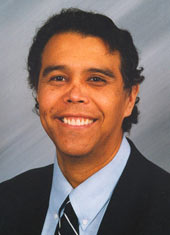AMES, Iowa -- The United Nations has begun diplomatic efforts to end the latest round of violence in the Middle East between Israel and the Lebanon-based Hezbollah terrorist organization. But Iowa State University Associate Professor of Religious Studies Hector Avalos -- author of the book "Fighting Words: The Origins of Religious Violence" (2005) -- sees no short-term solution.
Avalos' book centers on the history of religious conflicts in the Middle East. He believes that diplomatic efforts to end the region's unrest need to acknowledge the concept of "sacred space."
"In the book, I explain why religion causes violence. After studying a number of cases from the ancient world, a theory emerged related to scarce resources. Violent conflict usually results from a real or perceived scarcity of something valued," said Avalos. "In this case, the sacred space called 'The Holy Land' constitutes a scarce resource to Jews, Muslims, and Christians. There is not enough of it for every religion that claims it.
"There is more than one group there sharing that space, but as long as one group thinks it's sacred to them, the conflict is not going to end," he said. "The solution has to be a long-term educational effort targeted at both sides -- making them aware of how religious belief can create scarcity, and how the history of each religion bears instances where believers had moved toward a more symbolic view of sacred space that would allow more inclusion for others. The solutions being proposed now will only be temporary because they do not address the perceived scarcity of sacred space."
Sacred space a powerful influence
According to Avalos, sacred space can be more powerful than any of the economic or political concessions typically negotiated in resolving such disputes. He points out that Palestine's value has been mostly religious since it does not contain any large petroleum or mineral deposits. So understanding sacred space is central to resolving the conflict.
"You have to address this sacred space issue," he said. "All the others are little Band-Aids, and if you look at the history of the region for over 2,000 years, that's been the case. They have to look at the fundamental reason for the conflict, and address scarcities created by religious belief."
This latest conflict is now one week old, beginning last Wednesday after a Hezbollah cross-border raid ended with eight Israeli soldiers killed and two abducted. The land that became Israel has been the focal point of many conflicts in the region as both sides believe it is rightfully theirs.
Rebiblicalization of The Holy Land
Avalos reports that prior to the 20th century, some forms of Judaism had evolved toward the concept of "The Holy Land" as a poetic symbol instead of as a physical territory. But by the early 20th century there developed a "rebiblicalization of the Holy Land," which has ignited the region's unrest.
"Because people started reinterpreting the Bible more literally, then you began to see this physical space (in Israel) as sacred space," he said.
"Diplomats and other world leaders need to become aware of how religions are creating scarce resources. They need to encourage believers to ask why they cannot share certain spaces -- convincing them that there is a scarcity, and the realization that certain beliefs create scarcities in and of themselves."
The border to this "sacred space" continues to be the focal point of the present conflict. Israeli Premier Ehud Olmert has said it will not end its offensive until the two abducted soldiers are returned and Hezbollah is no longer permitted to deploy in south Lebanon and along the border with Israel.
